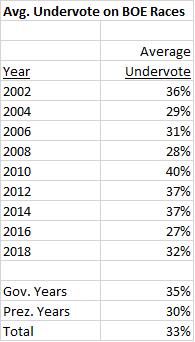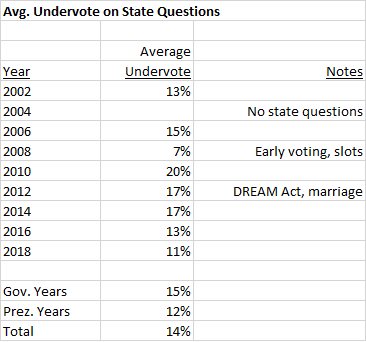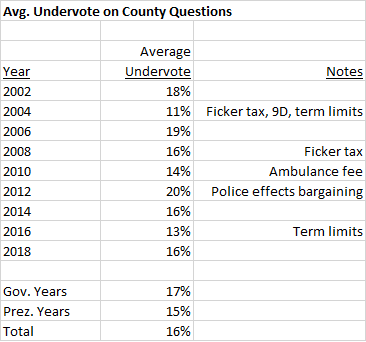By Adam Pagnucco.
This year has four hotly contested county ballot questions and at least one legitimately contested school board election. But here is something folks tend to forget: not everyone votes on these so-called “down ballot” races. And the question of who is not voting is almost as important as the question of who is.
In a presidential year, almost everyone who votes casts a vote for president. There are lots of other races at stake. This year, MoCo voters can also vote for Congress, judges, school board, two state ballot questions and four county ballot questions. However, there will inevitably be undervoting in many of these races. For the purpose of this post, the definition of “undervoting” is the percentage of people who cast a ballot but don’t vote in a particular contest. There is a lot of undervoting.
The table below shows undervoting in MoCo school board races since 2002. On average, one-third of people casting votes do not vote for school board.

The table below shows undervoting in MoCo for state ballot questions since 2002. On average, one in seven people casting votes do not vote on state ballot questions.

The table below shows undervoting in MoCo for county ballot questions since 2002. On average, one in six people casting votes do not vote on county ballot questions.

What determines undervoting? As shown in the tables above, undervoting seems to be a little less prevalent in presidential years, though not by much. Undervoting is much higher for school board races than ballot questions. That makes sense since – at least in some cases – voters can figure out how they feel about ballot questions from their language whereas school board candidates don’t have enough money to communicate directly with voters.
There is a little bit of evidence that clear and consequential ballot questions lead to less undervoting. County ballot question undervoting was lower than average in 2004 (when nine council districts and Ficker amendments on taxes and term limits were on the ballot) and in 2016 (when Ficker’s term limits amendment passed). State ballot question undervoting was about half the normal rate in 2008, when early voting and slots were on the ballot.
The table below shows the ballot questions with the lowest undervotes since 2002.

Four out of these five – slots, early voting, taxes and term limits – were big-deal questions. They were also relatively easy to understand for voters.
The table below shows the ballot questions with the highest undervotes since 2002.

There isn’t much of a pattern here. The police effects bargaining question in 2012 was the only question that was strongly contested.
One more thing that will be of interest to all the groups promoting or advocating against specific ballot questions this year: most ballot questions pass. Since 2002, MoCo voters have voted in favor of 81% of county ballot questions and 92% of state ballot questions.

Here are the results for the four county ballot questions that have failed since 2002.

All four – term limits (2004), nine council districts (2004), property tax limits (2004) and the ambulance fee (2010) – were the targets of vigorous campaigns dedicated to killing them. All four saw lower than average undervoting.
There will certainly be undervoting this year and the stakes for the county, especially from the county ballot questions, are especially high. How will that affect the outcome?
